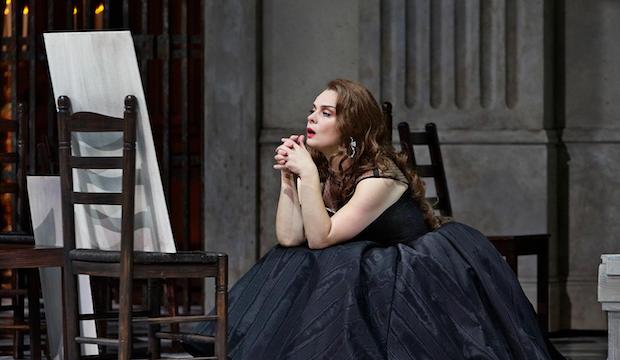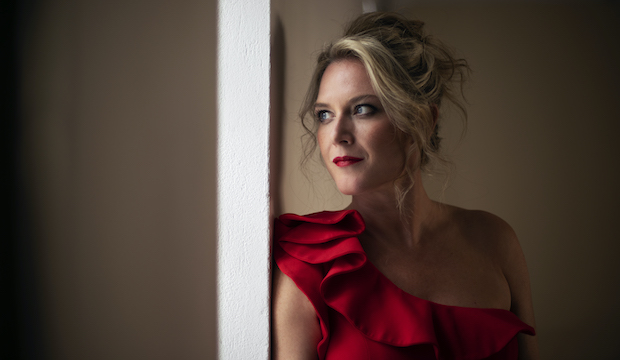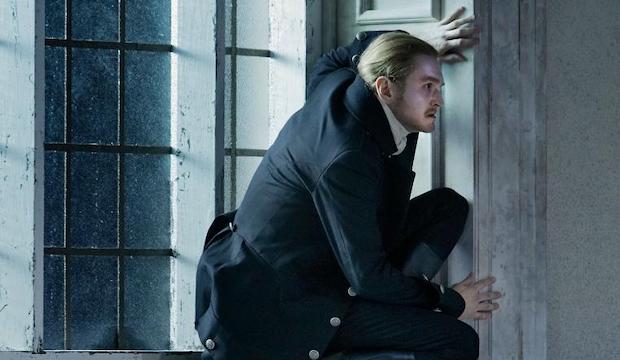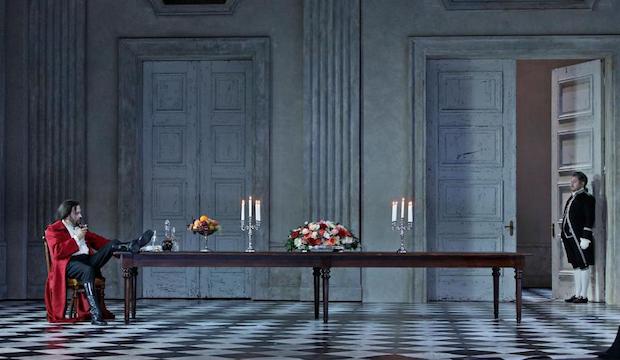Tosca: opera's multi-tasking woman
Puccini's brave heroine speaks for 21st-century women, says soprano Sinéad Campbell-Wallace, who has played the role four times
Sinéad Campbell-Wallace sings the title role in Tosca at English National Opera. Photo: Frances Marshall
An opera so famous it has cameo roles in films as varied as Quantum of Solace and Happy Feet Two clearly reaches people beyond the world's opera houses. But just what is it that makes Puccini’s Tosca so enduring and so pertinent to every generation of music-lovers?
Tosca has all the elements of a great drama: a deep love affair, a villain, courage in the face of danger, a shocking twist. And the Italian composer himself spotted the exceptional potential when he watched the great actress Sarah Bernhardt in the title role of the play La Tosca, created for her, by French writer Victorien Sardou, first performed in 1887.
But it was several years before Puccini's opera surfaced. It was premiered in January 1900, a century after the time in which it is set, and with its breakneck economy of action is tighter by far than the baggy five-acter on which it was based, thanks to his librettist Luigi Illica.
Tosca is Puccini’s fifth opera, and he nearly lost his option on the text to a rival until his publisher realised, with the help of interest from Giuseppe Verdi, that it needed a composer of Puccini's talent to do it justice. Even so, Puccini's operas Manon Lescaut and La Bohème were unveiled in the time it took to wrap up the deal.
Tosca was an immediate hit in Rome. It was premiered six months later at the Royal Opera House in London in July 1900, and staged there virtually every year until the 1970s. Covent Garden's current production, by Jonathan Kent, is a mainstay of the repertoire, and never fails to thrill.

Dark-haired Tosca is suspicious when she sees a blonde in her lover's art
Late last year Tosca was in the headlines again, when British-born tenor Freddie De Tommaso stepped in to Act Two at the Royal Opera House, at a few minutes’ notice, a career-defining moment. He returns to the role at Covent Garden (12 Dec), with soprano Natalya Romaniw in the title role, during the next run (28 Nov to 21 Dec). And Opera Holland Park is tee-ing up its 2008 production Tosca for summer 2024.
But in the meantime, there is a new Tosca in town. At English National Opera, the production by Christof Loy, already seen in Helsinki, promises to be thrillingly staged. In the title role is Sinéad Campbell-Wallace. A few days before curtain up, she explained to Culture Whisper how she approached the role, and why Tosca is so endlessly fascinating as an opera.
‘This is my fourth production of Tosca, and having done it before she’s in me,’ says the singer. ‘She’s in my bones. But you must come to the role each time with a freshness and a collaboration with the director.
‘There is a tendency to be generic about the character. Floria Tosca is an opera singer: histrionic and jealous. But I go back to the text, and I take it apart word by word, and look at it as a piece of prose. And there is nothing Tosca does that is not reasonable or rational.’
In the first act, when Tosca arrives at the church of Sant’Andrea della Valle in Rome, she thinks her lover, the painter Mario Cavaradossi, who is harbouring a political activist, is acting strangely.

Sinéad Campbell-Wallace has sung the title role of Tosca in four productions. Photo: Frances Marshall
‘She’s heard somebody, and the door’s locked, so she is within her rights to be suspicious. I think she’s reacting as any woman would react. Mario lies, and says there’s no one there. Tosca can guess that he is hiding someone. Then she sees this beautiful woman Mario is painting, with blonde hair and blue eyes.’ Tosca herself is a brunette….
‘She jumps to conclusions. Maybe Mario has a history of philandering. I don’t accept that she’ s irrational. But there is real love and affection. They have so much in common – they are both artists and playful. That passion becomes important later on.’
It is when Mario is arrested and tortured that Tosca is summoned to his captor’s rooms. Baron Scarpia, the chief of police in a turbulent Rome, is obsessed with the singer, and takes advantage of his power to control her. She arrives, reluctantly, straight after her performance.
‘In the current climate, with MeToo, I feel it’s a very real situation.’
The scene makes huge demands upon the singer. At its heart is the reproachful and very famous aria Vissi d’arte – ‘I lived for art’ – in which the exhausted and desolate Tosca wonders aloud why she is being tormented, when all she has done is live for her art and been a kind person. Then there is a struggle with a surprisingly violent outcome, as Tosca finds the strength to stab Scarpia to death. Vissi d’arte is a ‘To be or not to be’ moment: audiences know what’s coming, and it is preceded by an expectant silence.

Political activists are in danger in the Rome of 1800
‘Before you come in, you have to get out of your own head, in a way. You have to tell the story. I’m a vehicle and for the woman – for all women – in the in the sense of the situation she is in.’
Tosca has fought to the death to protect herself. ‘But she is devastated by what she has done, even though in the moment of killing Scarpia justice has been done. You have to remember that she was religious. She was orphaned and she was brought up by nuns.
‘After the murder, she feels the guilt. She’s scrabbling around for her sanity. She’s struggling to pull herself together. Then she has a plan, and she’s a woman who multi-tasks, as only a woman can. A man would lose the letter and forget to ring the man about the boat! She’s so rational.’
Straight after Scarpia’s murder, Tosca has the presence of mind to search for the papers that will allow her and Mario to travel freely. She also lights candles besides the body, in an improvised religious ceremony.
In the final act, she joins Mario on the battlements where the mock execution that was promised by Scarpia is to be staged, but Tosca does not suspect that Scarpia will have double-crossed her. When her lover falls lifeless before the firing squad she thinks he is acting. It is only when she spots their chance to escape unseen that she finds him dead and howls his name, chillingly and repeatedly, until all the music drains from her voice. Puccini specifies how each 'Mario' should sound.

Baron Scarpia summons Floria Tosca to his rooms in the Palazzo Farnese
‘The orchestral forces are so huge it’s almost as if she can’t sing any more, she is so bereft. She is such a strong character.’
By now, Scarpia’s murder has been discovered, and Tosca is a marked woman. ‘When they come for her, the reason that she jumps to her death is that she doesn’t want to give Scarpia, even in death, any satisfaction, so powerful is her desire to take control.’
After three production sung in Italian, Campbell-Wallace will be singing Tosca in an English translation for the first time. This brings vocal challenges.
‘Italian is a singer’s dream – very frontal in the mouth, very forward. English is the opposite – at the back and rather woolly. I like to ‘Italianise’ English vowels and then soften them.
‘The generic history of Tosca is as a jealous mad woman. We want to strip that down, and make her real, recognisable.’
Tosca directed by Christof Loy is at English National Opera 30 Sept to 4 Nov. Tosca directed by Jonathan Kent is at the Royal Opera House 28 Nov to 21 Dec. Tosca directed by Stephen Barlow returns to Opera Holland Park in June 2024
Tosca has all the elements of a great drama: a deep love affair, a villain, courage in the face of danger, a shocking twist. And the Italian composer himself spotted the exceptional potential when he watched the great actress Sarah Bernhardt in the title role of the play La Tosca, created for her, by French writer Victorien Sardou, first performed in 1887.
But it was several years before Puccini's opera surfaced. It was premiered in January 1900, a century after the time in which it is set, and with its breakneck economy of action is tighter by far than the baggy five-acter on which it was based, thanks to his librettist Luigi Illica.
Tosca is Puccini’s fifth opera, and he nearly lost his option on the text to a rival until his publisher realised, with the help of interest from Giuseppe Verdi, that it needed a composer of Puccini's talent to do it justice. Even so, Puccini's operas Manon Lescaut and La Bohème were unveiled in the time it took to wrap up the deal.
Tosca was an immediate hit in Rome. It was premiered six months later at the Royal Opera House in London in July 1900, and staged there virtually every year until the 1970s. Covent Garden's current production, by Jonathan Kent, is a mainstay of the repertoire, and never fails to thrill.

Dark-haired Tosca is suspicious when she sees a blonde in her lover's art
Late last year Tosca was in the headlines again, when British-born tenor Freddie De Tommaso stepped in to Act Two at the Royal Opera House, at a few minutes’ notice, a career-defining moment. He returns to the role at Covent Garden (12 Dec), with soprano Natalya Romaniw in the title role, during the next run (28 Nov to 21 Dec). And Opera Holland Park is tee-ing up its 2008 production Tosca for summer 2024.
But in the meantime, there is a new Tosca in town. At English National Opera, the production by Christof Loy, already seen in Helsinki, promises to be thrillingly staged. In the title role is Sinéad Campbell-Wallace. A few days before curtain up, she explained to Culture Whisper how she approached the role, and why Tosca is so endlessly fascinating as an opera.
‘This is my fourth production of Tosca, and having done it before she’s in me,’ says the singer. ‘She’s in my bones. But you must come to the role each time with a freshness and a collaboration with the director.
‘There is a tendency to be generic about the character. Floria Tosca is an opera singer: histrionic and jealous. But I go back to the text, and I take it apart word by word, and look at it as a piece of prose. And there is nothing Tosca does that is not reasonable or rational.’
In the first act, when Tosca arrives at the church of Sant’Andrea della Valle in Rome, she thinks her lover, the painter Mario Cavaradossi, who is harbouring a political activist, is acting strangely.

Sinéad Campbell-Wallace has sung the title role of Tosca in four productions. Photo: Frances Marshall
‘She’s heard somebody, and the door’s locked, so she is within her rights to be suspicious. I think she’s reacting as any woman would react. Mario lies, and says there’s no one there. Tosca can guess that he is hiding someone. Then she sees this beautiful woman Mario is painting, with blonde hair and blue eyes.’ Tosca herself is a brunette….
‘She jumps to conclusions. Maybe Mario has a history of philandering. I don’t accept that she’ s irrational. But there is real love and affection. They have so much in common – they are both artists and playful. That passion becomes important later on.’
It is when Mario is arrested and tortured that Tosca is summoned to his captor’s rooms. Baron Scarpia, the chief of police in a turbulent Rome, is obsessed with the singer, and takes advantage of his power to control her. She arrives, reluctantly, straight after her performance.
‘In the current climate, with MeToo, I feel it’s a very real situation.’
The scene makes huge demands upon the singer. At its heart is the reproachful and very famous aria Vissi d’arte – ‘I lived for art’ – in which the exhausted and desolate Tosca wonders aloud why she is being tormented, when all she has done is live for her art and been a kind person. Then there is a struggle with a surprisingly violent outcome, as Tosca finds the strength to stab Scarpia to death. Vissi d’arte is a ‘To be or not to be’ moment: audiences know what’s coming, and it is preceded by an expectant silence.

Political activists are in danger in the Rome of 1800
‘Before you come in, you have to get out of your own head, in a way. You have to tell the story. I’m a vehicle and for the woman – for all women – in the in the sense of the situation she is in.’
Tosca has fought to the death to protect herself. ‘But she is devastated by what she has done, even though in the moment of killing Scarpia justice has been done. You have to remember that she was religious. She was orphaned and she was brought up by nuns.
‘After the murder, she feels the guilt. She’s scrabbling around for her sanity. She’s struggling to pull herself together. Then she has a plan, and she’s a woman who multi-tasks, as only a woman can. A man would lose the letter and forget to ring the man about the boat! She’s so rational.’
Straight after Scarpia’s murder, Tosca has the presence of mind to search for the papers that will allow her and Mario to travel freely. She also lights candles besides the body, in an improvised religious ceremony.
In the final act, she joins Mario on the battlements where the mock execution that was promised by Scarpia is to be staged, but Tosca does not suspect that Scarpia will have double-crossed her. When her lover falls lifeless before the firing squad she thinks he is acting. It is only when she spots their chance to escape unseen that she finds him dead and howls his name, chillingly and repeatedly, until all the music drains from her voice. Puccini specifies how each 'Mario' should sound.

Baron Scarpia summons Floria Tosca to his rooms in the Palazzo Farnese
‘The orchestral forces are so huge it’s almost as if she can’t sing any more, she is so bereft. She is such a strong character.’
By now, Scarpia’s murder has been discovered, and Tosca is a marked woman. ‘When they come for her, the reason that she jumps to her death is that she doesn’t want to give Scarpia, even in death, any satisfaction, so powerful is her desire to take control.’
After three production sung in Italian, Campbell-Wallace will be singing Tosca in an English translation for the first time. This brings vocal challenges.
‘Italian is a singer’s dream – very frontal in the mouth, very forward. English is the opposite – at the back and rather woolly. I like to ‘Italianise’ English vowels and then soften them.
‘The generic history of Tosca is as a jealous mad woman. We want to strip that down, and make her real, recognisable.’
Tosca directed by Christof Loy is at English National Opera 30 Sept to 4 Nov. Tosca directed by Jonathan Kent is at the Royal Opera House 28 Nov to 21 Dec. Tosca directed by Stephen Barlow returns to Opera Holland Park in June 2024
TRY CULTURE WHISPER
Receive free tickets & insider tips to unlock the best of London — direct to your inbox